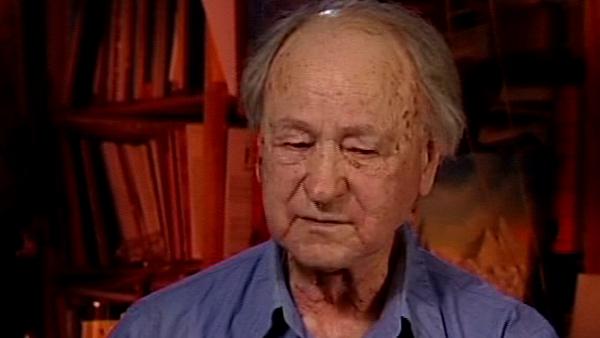NEXT STORY

Screening my first avant-garde film
RELATED STORIES

NEXT STORY

Screening my first avant-garde film
RELATED STORIES


|
Views | Duration | |
|---|---|---|---|
| 31. How I came to work at The Graphic Studios | 143 | 03:15 | |
| 32. Screening my first avant-garde film | 147 | 05:02 | |
| 33. Learning English | 228 | 06:22 | |
| 34. Different lives | 117 | 01:25 | |
| 35. How to stay dynamic | 130 | 02:50 | |
| 36. Influences and interests | 189 | 01:23 | |
| 37. The different kinds of cinema | 142 | 02:37 | |
| 38. Establishing Film Culture and The Village... | 135 | 02:03 | |
| 39. Doing what nobody else is doing | 139 | 03:51 | |
| 40. Finding time to sleep | 129 | 00:44 |


The first job actually, for several months, was in a Castro bed factory, they made beds, special bed called Castro beds, you know, beds, steel beds in Long Island City, Bebrian Bedding where I was, myself and my brother, there were like, the had like 300 workers, it was a big, big factory. Then I was fired, they just had to reduce, they had to expand to, expanded. Then I applied some of my machinery knowledge that I learned in the forced labour camp to work with drills and things. I worked in some other little factory. Then I worked in a laundry, ironing, that was horrible. I used to come home and from the steam I used to be like puffed up and you cannot imagine. I used to look in the mirror – all so white, puffed up because the steam, like ironing with steam, like puffs you up and washes you out. It's like you've been soaking for 12 hours, for eight hours and it was horrible. So, there I stayed two weeks and I left. I moved around until I decided that maybe I should look something that is more to what I'm interested in and I was very lucky. I found a job in Manhattan on 22nd Street and 6th Avenue. The Graphic Studios; they needed a delivery boy and their photography. So I started just taking packages around and it was a photography place run by a very prominent, really, photographer taking colour photography technician, Perskie. But I met there all kinds of people. They did work for Life Magazine, for international editions of Life Magazine, so very, like in three, four, five months I was promoted already to the cameras and I ended up by being one of their sort of chief, you know, camera people doing, making reproductions and copies, etc. But then all kinds of people used to come to do like, that's where I met people like Archie Pencote and some photographer that are quite well-known now, used to come there and hang around.
Jonas Mekas (1922-2019), Lithuanian-born poet, philosopher and film-maker, set up film collectives, the Anthology Film Archive, published filmzines and made hundreds of films, all contributing to his title as 'the godfather of American avant-garde cinema'. He emigrated to America after escaping from a forced labour camp in Germany in 1945.
Title: How I came to work at The Graphic Studios
Listeners: Amy Taubin
Amy Taubin is a contributing editor for "Film Comment" magazine and "Sight and Sound" magazine. Her book, "Taxi Driver", was published in 2000 in the British Film Institute's Film Classics series. Her chapter on "America: The Modern Era" is part of "The Critics Choice" published by Billboard Press, 2001, and her critical essays are included in many anthologies, mostly recently in "Frank Films: The Film and Video Work of Robert Frank" published by Scalo.
She wrote for "The Village Voice" weekly from 1987 into 2001 both as a film and a television critic. She also wrote a column for the "Village Voice" titled "Art and Industry" which covered American independent filmmaking. Her first weekly film criticism job was at the "SoHo Weekly News". Her writing has also appeared in "Art Forum", the "New York Times", the "New York Daily News", the "LA Weekly", "Millennium Film Journal", "US Harpers Bazaar" and many other magazines. She is a member of the National Society of Film Critics and the New York Film Critics Online.
She started her professional life as an actress, appearing most notably on Broadway in "The Prime of Miss Jean Brodie", and in avant-garde films, among them Michael Snow's "Wavelength", Andy Warhol's "Couch", and Jonas Mekas' "Diaries, Notebooks and Sketches".
Her own avant-garde film, "In the Bag" (1981) is in the collection of the Museum of Modern Art and the Friends of Young Cinema Archives in Berlin.
She was the video and film curator of "The Kitchen" from 1983-1987.
She has a B.A. from Sarah Lawrence College and an M.A. from N.Y.U. in cinema studies. She teaches at the School of Visual Arts in both the undergraduate and the MFA graduate programs, and lectures frequently at museums, media centers, and academic institutions. In 2003, she received the School of Visual Arts' art historian teaching award.
Tags: Castro Bed Factory, Life Magazine, The Graphic Art Studio, Leon A Perskie, Archie Pecote
Duration: 3 minutes, 16 seconds
Date story recorded: September 2003
Date story went live: 24 January 2008